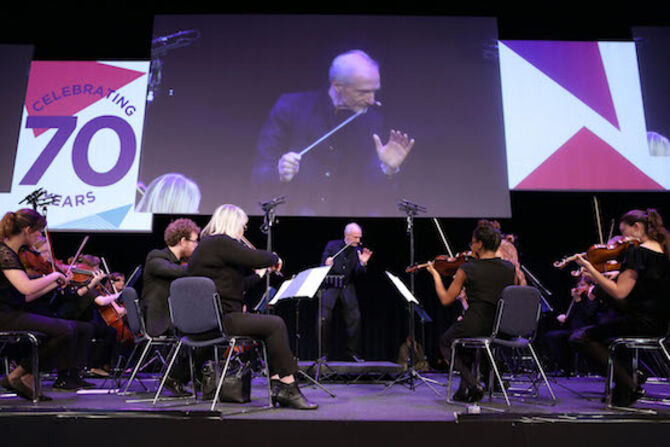Working in concert: leading high-performance organisations
Professor Gernot Schulz, acclaimed conductor and honorary professor, University of Music and Performing Arts in Hamburg, closed the CIPD annual conference with a rousing demonstration of how leaders can stay in tune with teams across borders.

Transformational leadership and creating meaning
Talking to Relocate Global about leading and conducting highly trained individuals to flawless performance and new heights of innovation and endeavour, Professor Schulz was keen to demystify the role of conductors in the creative process. In common with many organisations, what the orchestra set-up looks like from the outside is often very different from the inside, begins Professor Schulz. “A conductor’s role isn’t what it looks like: that is, standing at the front, waving a baton!” he explained. “As leaders, we need special skills. All the important things are beyond our order and command. They have to come out and develop from the team – a transformational kind of leadership.”For Professor Schulz, the primary role of the conductor or leader in building the conditions for success is to create meaning and communicate that. “We have to create a common passion. If you demand high performance, you have to give it meaning. In most cases, people know how they have to do their jobs and the challenges of this. But quite often, they do not know why.“As an orchestra, we do not produce anything. We do not offer a service that is necessary. We need to make people excited about what we are doing. If I, as a conductor, am never excited by what we are doing, then the orchestra will never be excited by it. It’s like a chain – the chain starts with me, the leader.“This is maybe the core challenge: to make people committed, to make the orchestra committed, even if they have individualistic views and are individualistic.”Perception is fundamental to high performance
At the core of creating meaning are a conductor’s perception and intuition; the result of deep personal learning and passion. “My lifelong challenge is to go into the scores, to look at every note, to think about every dynamic – every crescendo, every pianissimo – and ask, 'what does it mean?'“Our role as conductors and leaders is therefore actually to perceive and intuit,” continues Professor Schulz, who conducted and played with the Berlin Philharmonic orchestra, and was assistant to Leonard Bernstein and Georg Solti. “Perception links to precision, which is the basis of good, orchestrated action. I have to be the best perceiver in the orchestra company and communicate that.“Bosses and CEOs are the centre of communication," he continues. “They always have to be aware that the experiences are different in other parts of the organisation. Not that they have to justify everything, but to acknowledge that everyone in the organisation has a role, rather than just plays a role.”Perceiving and playing
In one of a number of cross-overs between the orchestral and corporate realm, the conversation turns to recruitment and engaging with high-performing individuals and teams.Underscoring the role of perception and intuition in the orchestra, Professor Schulz described the year-long probation used among some professional orchestras for its musicians – a process that ensures a good fit between the individual and the rest of the orchestra.“It is very important in an orchestra that everybody is a perfect virtuoso on their instrument,” says Professor Schulz. “But an orchestra knows very well even the best virtuoso playing is not enough for good orchestrated interaction. During this time, the orchestra is checking if the player is as good at perceiving and creating togetherness as they are a player.”Transparency and trust in delivering high performance
Transparency and harmony running throughout the operation are critical to maintaining and communicating accurate perceptions, believes Professor Schulz. Here again there are links to the corporate world; this time for performance management.“If I do not appreciate a good performance, I send the unspoken message I have not noticed or do not care for it."The same for poor performance. If I do not acknowledge it, then I allow it. It is very important for me as a leader to be transparent.“Maybe an interesting link to companies’ work is we have in rehearsals complete transparency,” he says. “Everyone sees and knows the mistakes of the others. This creates a perfect error-management culture. We have a concrete and open way to deal with it, which creates a lot of trust because it’s a very human kind of communication.“If the mistake is because of a lack of attention, then I start to address it in degrees. I just repeat. To 90% of members of the orchestra, they will realise very quickly by themselves and will automatically adjust. If there is no improvement, then I focus the attention of the whole team, of the whole orchestra. Then they realise we have to change something.“If things still aren’t improving, I will say, ‘you do know it is broken, right?’ I will try always to develop people – that is not to tell them what is wrong, because then I take the responsibility away from them. I take over. No, I put questions to people. That’s how we deal with mistakes.“If you meet someone you don’t know very well and you confess a weak point or weakness, then you have ventured towards creating a high degree of trust and demanding also trust of course,” he continues. "That is what we are doing all the time in an orchestra. Rehearsing means we makes our mistakes before the performance. Being open with our mistakes means there’s a good chance we will avoid it the next time. This is very important.”This safe space to make mistakes and learn is fundamental to good perception. It reduces stress and therefore increases our ability to perceive. “The moment your stress level goes up, human nature has the consequence our level of perception goes down,” says Professor Schulz. ”You limit your horizons. You lose the ability to perceive in a very refined way. This is a real challenge. I think every good team has to be aware of the importance of members’ ability to perceive each other, and to know about the strengths and the weaknesses of individuals.”Related articles from the winter 2017 issue of Relocate magazine:
- Making D&I count: constructive disruption and more human HR
- Flexible working for international frontiers
- Creative recruitment at Mandarin Oriental Hyde Park
Non-verbal communication
Key to achieving this level of understanding between team members is actively seeking ways to create personal connections.“Meeting and communicating in a direct way creates a lot of togetherness, and supports the perception in a professional process,” says Professor Schulz. “In business, as a leader, there are so many examples where you can create a better perception of yourself. It starts with the office you have. Are you in a closed box? Things like that.”Non-verbal communication is a critical aspect of this, says Professor Schulz. “Non-verbal communication is linked to the subconscious,’ he explains. “It is the result of all life experience. There is a saying that ‘the tongue can lie, but the body cannot.’ You have to have that in mind; you can be read by people around you and body language is a very strong power.”In his Manchester CIPD conference endnote speech, Professor Schulz demonstrated the ability and will of individual musicians to perceive and be perceptive of each other with help from musicians of the city’s recently formed Piccadilly Symphony Orchestra.He dispersed violinists from their section off the stage and into the audience, then asked them to play together. The musicians performed exceptionally, continuing to engage and stir the audience. Nevertheless, the audience could also perceive at close hand the challenges of this re-organisation, including how the musicians could communicate and lead each other across a much wider space. Delegates could also discern how the players responded by continuing to pay close attention to each other, and using exaggerated body language to determine tempo and cue performance notes.Knowing when to lead and when to guide
Given the interconnectedness of businesses across organisations and boundaries, how does this realm of non-verbal communication and eliciting emotional responses work for managers and members of global and remote teams who are rarely in the same physical space?“Nowadays, in the business world, the challenge of is becoming bigger and bigger every day because there are often dislocated teams all over the world and on different continents,’ observes Professor Schulz. “This makes the whole exercise really, really challenging.“Other kinds of communication are necessary because you can’t always see the person you are communicating with. But we still have meetings and still have eye-to-eye contact and limbic [emotional] contact. This, for human beings, is the most important for human communications.“And now we are going more and more away from hierarchy. This means people can’t always rely on being told what to do. I don’t want to overstretch the orchestra metaphor, but creating the conditions for success is about becoming a unit with a very refined way of interacting.“In most cases, it’s a lot about discipline and about having a common creativity: 95% is the orchestra and 5% is the conductor/leader. Yet, the overall picture, the meaning of the piece of music/of our work, is completely, 100%, the responsibility of the conductor/leader," says Professor Schulz.“This part of leadership is very directive, very authoritarian and it will be not discussed or changed. It’s the result of my lifelong research: concentrating on going into the scores, into the composer’s life, into his mood when he wrote the music, into his will of expression, using all possible sources and consulting experts. At the end of this process there is my deep conviction, which has become a part of me, which I stand for.“Especially in times of increasing individual responsibility and space of action caused by flat hierarchies, widespread companies, rapid change and agility etc, this part of leadership has to be strong and clear. To impart, to convey, that meaning to all parts of the orchestra/company is not a matter of order and command. It is the part transformational leadership: communicating this meaning by a moving communication."Bringing vision to life
This time demonstrating with a soloist playing the French Horn, Professor Schulz explored again what such transformational leadership looked like in practice. As the musician performed, Professor Schulz turned to face the him and limited his conducting instructions, allowing the soloist to lead the way.“For a leader, there is a very slim edge of doing too little – creating uncertainty and frustration – and doing too much, which creates inattentiveness and the feeling of being narrowed, being gegangelt,” says Professor Schulz.“That’s when a leader explains something to somebody who already knows what he/she explains. Then the person thinks: ‘Why does my leader not know that I know that already?’ This undermines the standing, competence and authority of the leader,” he explains.“Conductors are always thinking about how to reduce and minimise their instruction to give a feeling of freedom. They are showing the important points to direct energy.”Summing up the conductor’s role in releasing high performance, Professor Schulz believes less is more, but at its heart is creating meaning and bringing that to life. “Everything which is printed down, all the laws, all the companies’ values, all that is fixed are very important. But at the very end, it is printed paper. To make that alive, to make that real, that’s the responsibility of our leaders. At that moment, the best we can do is co-ordinate, support and help individuals create the space of autonomy.”
 Access hundreds of global services and suppliers in our Online Directory
Access hundreds of global services and suppliers in our Online Directory
©2025 Re:locate magazine, published by Profile Locations, Spray Hill, Hastings Road, Lamberhurst, Kent TN3 8JB. All rights reserved. This publication (or any part thereof) may not be reproduced in any form without the prior written permission of Profile Locations. Profile Locations accepts no liability for the accuracy of the contents or any opinions expressed herein.




































